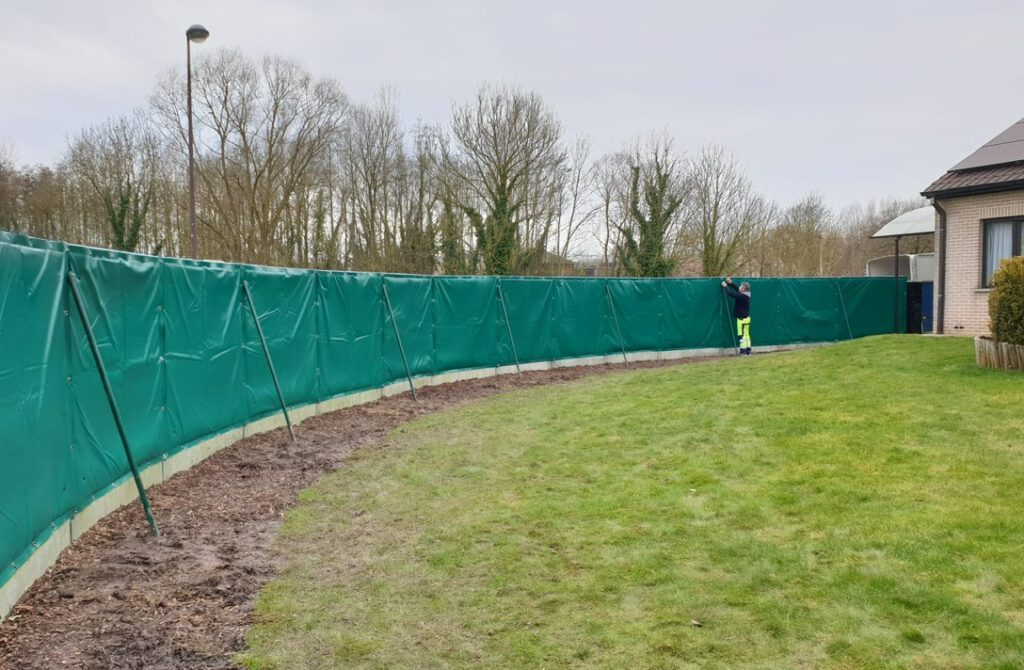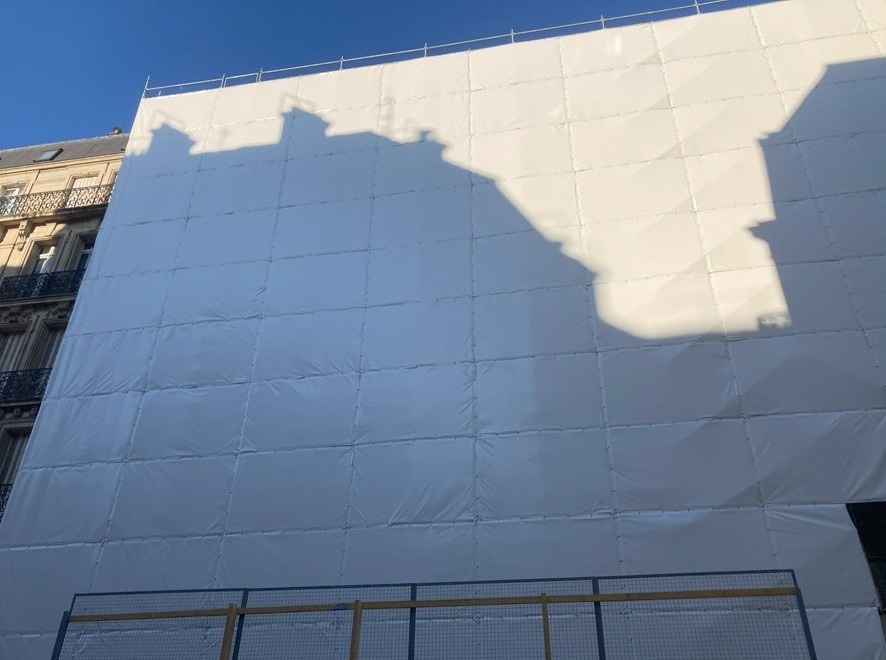Our sound barrier mats for construction sound barrier fences provide an effective noise protection against construction noise for outdoor areas and construction sites. Our flexible and foldable outdoor acoustic barrier mats offer an excellent price-performance ratio and are specially designed to achieve impressive noise reduction of up to -33 dB in the premium version.
 Sound barrier mats for construction sound barrier fences
Sound barrier mats for construction sound barrier fences
Why should you buy our acoustic sound protection mats?
- Noise reduction up to 33 dB (in the premium version, depending on the noise frequency!)
- Long lifespan due to robust materials, even under UV radiation
- Maintenance free
- Very easy to install with cable ties (and even lighter in the compact version)
- Comply with legal requirements for noise protection standards on construction sites, avoiding unplanned interruptions and complaints from residents
Use our soundproofing mats for construction fences to create a mobile sound barrier fence. Our UV and weather-resistant outdoor acoustic protection mats also meet the highest standards according to ISO 15186-2, achieving a sound insulation rating of 16 dB, 20 dB or 23 dB as confirmed by a noise absorption certification report, which can be sent to you in German language.
We follow the Tesla principle, largely avoiding expensive marketing. As a medium-sized company, we also don’t have expensive management overhead. This means we can offer you excellent product quality „Made in the EU“ at a relatively low price.
Buy our best in class sound barrier mats – for outdoor use e. g. at construction sites and to be attached on construction fences!
Features of our sound barrier mats for construction fences:
- Superior Noise Reduction
Thanks to their innovative design, our noise protection mats provide exceptional noise reduction of up to -33.1 dB. The flexible and foldable design allows easy adaptation to various environments and requirements. For example, noise protection mats can be easily attached to standard construction fences (2m x 3.5m) or scaffolding.
- It is important to ensure a statically stable construction that withstands the strongest wind loads, such as using heavy concrete weights, water-filled IBC containers, or supports!!!
- Certified Sound Insulation
Our premium noise protection mats meet the stringent requirements of ISO 15186-2 and have an impressive sound insulation rating of 16 dB in the standard version, 20 dB in the Plus version, and 23 dB in the premium version. This certification ensures not only high quality but also the effectiveness of our products against (construction) noise.
- Versatile and Easy to Use
The reusable noise protection mats are ideal for construction sites, events, and other areas where a noise-free environment is crucial. Their flexible design allows for easy handling and adaptation to various situations. The sound-absorbing mats can be carried by one person and easily mounted with cable ties by two people.
- Reusable and Long-Lasting
Our outdoor noise protection mats set standards not only in terms of sound insulation but are also reusable and particularly durable. Depending on their treatment, they can be used on your construction sites for several years.
Invest in premium sound insulation for a quieter and more efficient construction site environment. Contact us today to learn more about our flexible and foldable premium noise protection mats!
Customized construction noise reduction solutions available
Of course, you can also contact us directly to discuss custom solutions (e.g., complete enclosures for even the largest construction sites, such as demolition work near hospitals, nursing homes, schools, or kindergartens) tailored to your specific requirements. We also offer flame-retardant or custom-printed versions of the sound barrier mats.
 Customized sound proofing for construction sites
Customized sound proofing for construction sites
Overview of our Construction Site Soundproofing Mats offered
- Standard Sound Barrier Mats with 16 dB Sound Insulation Rating
Our 16 dB noise protection mats provide effective noise protection for use on construction sites. The special material absorbs sound waves, achieving a significant reduction in noise levels.
- Plus Acoustic Sound Barrier Mats with 20 dB Sound Insulation Rating
For maximum sound insulation on construction sites, we recommend our noise protection mats with a 20 dB insulation rating. These mats offer a powerful solution for construction projects with particularly high noise requirements.
- Compact Soundproofing Barrier Mats 4.0 with 20 dB Sound Insulation Rating (in 2 x 1.2 m size)
- Our Best in Class Acoustic Sound Barrier Mats with 23 dB Sound Insulation Rating
Buy our noise absorbing mats for a quieter construction site today!
Invest in the safety and well-being of your workers with our high-quality sound barrier mats. Choose between 16 dB and 23 dB insulation ratings to meet the specific requirements of your construction site. Order now and optimize the working conditions on your site!
Which countries have strict regulations on construction noise?
In addition to Germany, several other European countries have implemented strict regulations on construction noise to protect public health and minimize noise pollution. Here are some of them:
- Germany: Germany has comprehensive regulations on construction noise, including specific limits on noise levels and designated quiet hours, which are even stricter in spa towns or next to hospitals, schools, retirement homes and kindergartens. The Federal Immission Control Act (Bundes-Immissionsschutzgesetz) and the Technical Instructions on Noise Abatement (TA Lärm) are key regulations governing noise emissions from construction sites.
- United Kingdom: The UK has strict guidelines on construction noise, managed under the Control of Pollution Act 1974. Local authorities enforce noise limits and can issue notices requiring measures to reduce noise. The Environmental Protection Act 1990 also addresses noise nuisances.
- Sweden: Sweden has strict noise regulations managed by the Swedish Environmental Protection Agency. The Environmental Code and the Ordinance on Noise in Construction Work (Byggnadsarbeten) set specific noise limits and operational hours for construction activities.
- France: France has comprehensive noise regulations governed by the Environmental Code and the Noise Regulation (Code de l’environnement and Décret bruit). Local authorities enforce noise limits and can impose fines for violations. Quiet hours and permissible noise levels are strictly controlled.
- Denmark: Denmark’s Environmental Protection Act includes detailed regulations on construction noise. The Danish Environmental Protection Agency (Miljøstyrelsen) sets noise limits and provides guidelines to minimize noise impact on residential areas.
- Netherlands: The Netherlands has strict noise regulations under the Environmental Management Act (Wet Milieubeheer) and the Noise Abatement Act (Wet geluidhinder). These laws set noise limits for construction sites, especially in residential areas, and enforce measures to reduce noise pollution.
- Norway: Norway has rigorous noise control regulations under the Pollution Control Act (Forurensningsloven) and specific guidelines for construction noise. The Norwegian Environment Agency (Miljødirektoratet) sets noise limits and enforces compliance.
- Finland: Finland’s Environmental Protection Act and related regulations govern construction noise. The Finnish Environment Institute (Suomen ympäristökeskus) provides guidelines and enforces noise limits to protect public health and the environment.
- Austria: Austria has strict noise regulations under the Federal Noise Protection Act (Bundes-Lärmschutzgesetz). The Austrian Federal Environmental Agency (Umweltbundesamt) sets noise limits for construction activities and enforces measures to reduce noise impact.
- Switzerland: Switzerland’s Federal Noise Abatement Ordinance (Lärmschutz-Verordnung, LSV) sets stringent limits on construction noise and mandates measures to mitigate noise emissions, particularly in residential areas.
- Spain: Spain has comprehensive noise regulations under the Law on Noise (Ley del Ruido) and related royal decrees. Local municipalities enforce noise limits and can issue fines for violations. Specific quiet hours and permissible noise levels are defined to minimize noise pollution.
- Italy: Italy’s noise regulations are governed by the Framework Law on Noise Pollution (Legge quadro sull’inquinamento acustico) and related decrees. Local authorities set specific noise limits and enforce compliance to protect public health.
These countries have recognized the significant impact of construction noise on public health and the environment, leading to the implementation of strict regulations and enforcement measures to control and mitigate noise pollution from construction activities.
Outside Europe here are some of the countries known for having stringent regulations:
- United States: In the US, construction noise regulations vary by state and city. Major cities like New York, San Francisco, and Los Angeles have strict noise control ordinances. The Occupational Safety and Health Administration (OSHA) also sets noise exposure standards to protect workers.
- Australia: Australian cities have stringent noise regulations, particularly in New South Wales and Victoria. The Environment Protection Authority (EPA) in each state provides guidelines and enforces noise limits. For example, Victoria’s EPA sets specific noise limits and restrictions on construction hours.
- Japan: Japan has strict regulations on construction noise, governed by the Noise Regulation Law. This law sets permissible noise levels and enforces measures to mitigate noise pollution, especially in residential areas.
- Singapore: Singapore has stringent noise regulations enforced by the National Environment Agency (NEA). The Environmental Protection and Management Act sets noise limits for different times of the day, with stricter controls during nighttime and on weekends.
- Canada: In Canada, noise regulations are managed at the provincial and municipal levels. Cities like Toronto and Vancouver have strict noise bylaws that set limits on construction noise and regulate construction hours.
(Please note we do not guarantee completeness or accuracy of the above list!)
Where can sound barrier mats be used?
- Construction Sites: Sound barrier mats are often deployed around construction sites to reduce noise levels generated by heavy machinery, equipment, and construction activities. They help minimize disturbances to nearby residents and businesses. Main application is as a sound barrier fence.
- Highways and Roads: Along highways and busy roads, soundproofing mats are installed to mitigate traffic noise and improve the quality of life for nearby residents. These barriers can be erected along the roadside or on bridges to absorb and block sound waves.
- Railways and Train Tracks: Acoustic barrier mats are used along railway lines and train tracks to reduce noise from passing trains. They help prevent noise pollution in residential areas located near railway corridors.
- Industrial Facilities: In industrial areas, noise barrier mats are installed to contain noise emissions from manufacturing plants, factories, and processing facilities. They help minimize the impact of industrial noise on surrounding neighborhoods.
- Outdoor Events: Sound absorbing mats can be deployed at outdoor events such as concerts, festivals, and sports events to reduce noise levels and prevent sound from disturbing nearby residents. They create quieter zones within event venues.
- Commercial Buildings: In urban areas, sound barrier mats are used in commercial buildings to enhance acoustic insulation and minimize noise transfer between different spaces. They help create quieter and more comfortable indoor environments for occupants.
- Residential Areas: In densely populated residential areas, acoustic barrier mats are installed to reduce noise from nearby roads, railways, airports, and other sources. They improve the quality of life for residents by creating quieter living environments.
- Hospitals and Healthcare Facilities: Sound barrier mats are used in hospitals and healthcare facilities to minimize noise disturbance for patients, staff, and visitors. They help maintain a peaceful and healing environment conducive to recovery.
- Educational Institutions: In schools, colleges, and universities, sound barrier mats are installed to reduce noise from nearby roads, playgrounds, and other sources like construction site. They create quieter learning environments that enhance concentration and academic performance.
- Public Spaces: Acoustic Sound barrier mats can be used in public parks, plazas, and recreational areas to reduce noise levels and create more peaceful outdoor environments for relaxation and leisure activities.
Overall, sound barrier mats and fences are versatile and mobile solutions for controlling noise pollution in various settings, improving acoustic comfort, and enhancing the quality of life for people in both urban and rural areas.